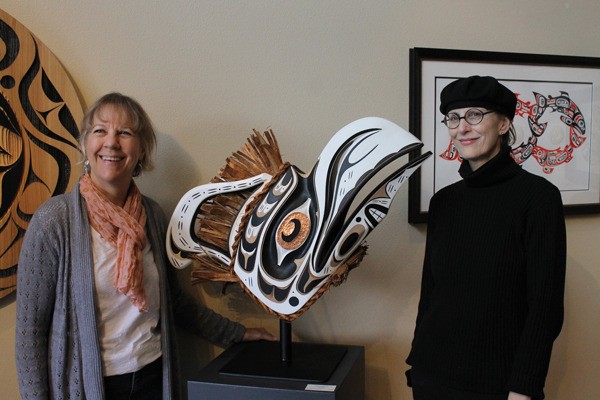An artist’s final product is an aggregate of themselves, their method and oftentimes their surroundings. This is especially true at Arctic Raven Gallery, a fine art gallery that features work from Arctic and Northwest Coast Native Americans.
Many pieces have a story attached to them whether it’s from the artist, the tribe or the medium, like the fossilized woolly mammoth tooth pendants or whale bone sculptures.
Manager Julie Vouri said a unique part to the job is the opportunity to educate people on Native art and their process, which draws from time-honored methods of carving, sculpting and painting.
“This art is so informed by place, and where they live,” said Vouri. “Some of this art is third and fourth generation, so they’ve been learning from their parents, uncles, elders and it’s been passed on from generation to generation, so there is definitely a sense of longevity.”
Vouri, who previously worked as a writer and editor for 30 years and has lived on San Juan Island for the last ten years, said she was first drawn to work at the gallery out of an interest in Northwest Coast art.
“This is my first experience in a gallery,” Vouri said. “Lee Brooks has owned the gallery for about 20 years, and is very knowledgeable, so I thought I could get an education as well.”
Display Designer Jacke Vautrin has lived and worked on San Juan Island for the past nine years off and on, while also working at galleries and museums in Seattle including Seattle Arts Commission, the Henry Art Gallery and Greg Kucera’s Secondary Market Gallery.
Vautrin, whose background is in horticulture and art, said that art pieces found at Arctic Raven Gallery and informed by the place the artists live and uses place-based materials like cedar, argillite, bone, walrus ivory and soapstone. In turn, the art mirrors the people and animals found in those environs.
“It’s so resourceful; whatever is there is what they work with,” Vautrin said. “For me, I really enjoy and appreciate the stonework like the Cape Dorset serpentine pieces. The carving is so wonderful.”
The gallery is host to a number of artists who are related, and Vautrin points out a rattle, mask and carving made by a brother, father and uncle. The familial links seem to give the works extra depth and emotion, as similar styles can be detected in the methods passed down through generations, as well as departures from traditional art forms or abstracted versions that use different shapes, colors and mediums.
One of Vouri’s current favorite sculptures is “Woman” by Edwin Noongwook, an Alaskan Yupik artist. The woman, dressed in simple clothing with an unsmiling expression, is carved from a single whale bone.
“Some of the artists doing sculptures and carving, they can get such expression and movement through such a simple piece like that,” Vouri said.




